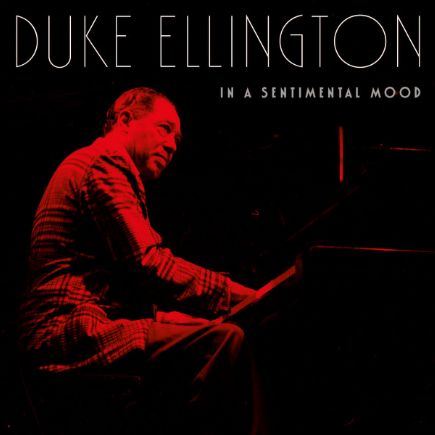I Let a Song Go Out of My Heart: élégance mélancolique et swing orchestral
Composée par Duke Ellington en 1938, I Let a Song Go Out of My Heart naît dans un contexte à la fois anecdotique et révélateur. Selon la légende, Ellington aurait esquissé le morceau lors d’un voyage en voiture avec son orchestre, alors qu’il résidait temporairement dans un hôtel de Memphis. Les paroles seront ajoutées par Irving Mills, John Redmond et Henry Nemo – ce dernier prétendant, non sans humour, avoir trouvé l’inspiration… assis aux toilettes!
Irving Mills rapporte par ailleurs qu’Ellington avait conçu douze pièces pour la Cotton Club Parade, et que, par superstition, la treizième – I Let a Song Go Out of My Heart – fut volontairement écartée du programme. D’autres sources suggèrent que c’est Mills lui-même qui prit cette décision. Quelle qu’en soit l’origine exacte, la chanson connaîtra un immense succès dès sa sortie, devenant l’un des titres phares de l’univers ellingtonien.
Musicalement, l’œuvre illustre avec éclat la signature de Duke Ellington: un swing élégant, une orchestration soignée, et une profondeur émotionnelle qui transcende la forme. La mélodie, fluide et légèrement mélancolique, séduit par son pouvoir évocateur. Elle explore le thème universel de la perte – ici, celle d’une chanson qui s’éloigne comme un amour perdu – avec une délicatesse qui touche l’auditeur sans jamais sombrer dans le pathos.
L’art de l’élégance orchestrale selon Ellington
Enregistrée à Broadway le 3 mars 1938, quelques jours avant le lancement de la Cotton Club Parade, cette version originale de I Let a Song Go Out of My Heart illustre à merveille le raffinement musical de Duke Ellington à l’apogée de sa carrière.
La formation réunit une constellation de talents: Wallace Jones et Cootie Williams aux trompettes, Rex Stewart au cornet, Lawrence Brown, Joe ‘Tricky Sam’ Nanton et Herb Flemming aux trombones, Otto Hardwick et Johnny Hodges aux saxophones alto, Barney Bigard au ténor et à la clarinette, Harry Carney au baryton, Fred Guy à la guitare, Billy Taylor et Hayes Alvis aux basses, et Sonny Greer à la batterie.
Ellington, au piano et à la direction, orchestre avec finesse un ensemble dont l’équilibre et la réactivité sont exemplaires. Le solo de Johnny Hodges, tout en lyrisme et en retenue, insuffle à la mélodie une douceur mélancolique d’une grande justesse. Son phrasé soyeux donne à l’ensemble une profondeur émotionnelle rare.
Cette œuvre, rapidement devenue l’un des grands standards du jazz, s’inscrit dans une période décisive de collaboration avec Irving Mills, manager et producteur influent qui contribue à faire connaître les compositions d’Ellington à un public élargi.
I Let a Song Go Out of My Heart: elegancia melancólica y swing orquestal
Compuesta por Duke Ellington en 1938, I Let a Song Go Out of My Heart nace en un contexto tan anecdótico como revelador. Según la leyenda, Ellington bosquejó el tema durante un viaje en coche con su orquesta, mientras se alojaba temporalmente en un hotel de Memphis. La letra fue añadida por Irving Mills, John Redmond y Henry Nemo, quien afirmó, no sin humor, que la inspiración le vino… sentado en el baño.
Irving Mills relató también que Ellington había escrito doce piezas para la Cotton Club Parade y que, por superstición, la decimotercera – I Let a Song Go Out of My Heart – fue excluida deliberadamente del programa. Otras fuentes sostienen que fue el propio Mills quien tomó la decisión. Sea cual sea el origen exacto, la canción tuvo un éxito inmediato, convirtiéndose en una de las obras más representativas del universo ellingtoniano.
Musicalmente, la obra resume con brillantez la firma estilística de Duke Ellington: un swing refinado, una orquestación meticulosa y una profundidad emocional que va más allá de la forma. La melodía, fluida y sutilmente melancólica, conquista por su capacidad evocadora. Explora el tema universal de la pérdida – aquí, la de una canción que se aleja como un amor perdido – con una delicadeza que conmueve sin caer nunca en el sentimentalismo.
El arte de la elegancia orquestal según Ellington
Grabada en Broadway el 3 de marzo de 1938, pocos días antes del inicio de la Cotton Club Parade, esta versión original de I Let a Song Go Out of My Heart ilustra con maestría la sofisticación musical de Duke Ellington en el apogeo de su carrera.
La formación reúne una constelación de talentos: Wallace Jones y Cootie Williams en las trompetas, Rex Stewart en el cornetín, Lawrence Brown, Joe ‘Tricky Sam’ Nanton y Herb Flemming en los trombones, Otto Hardwick y Johnny Hodges en los saxofones altos, Barney Bigard en el tenor y la clarinete, Harry Carney en el barítono, Fred Guy en la guitarra, Billy Taylor y Hayes Alvis en los contrabajos, y Sonny Greer en la batería.
Ellington, al piano y a la dirección, orquesta con una fineza extraordinaria un conjunto cuyo equilibrio y sensibilidad colectiva son ejemplares. El solo de Johnny Hodges, lleno de lirismo contenido, infunde a la melodía una melancolía suave de notable precisión. Su fraseo sedoso confiere a la pieza una profundidad emocional poco común.
Esta obra, que se convirtió rápidamente en uno de los grandes estándares del jazz, se inscribe en un periodo clave de colaboración con Irving Mills, influyente mánager y productor que contribuyó decisivamente a difundir las composiciones de Ellington a un público más amplio.
I Let a Song Go Out of My Heart: eleganza malinconica e swing orchestrale
Composta da Duke Ellington nel 1938, I Let a Song Go Out of My Heart nasce in un contesto tanto aneddotico quanto significativo. Secondo la leggenda, Ellington avrebbe abbozzato il brano durante un viaggio in auto con la sua orchestra, mentre soggiornava temporaneamente in un hotel a Memphis. Il testo fu aggiunto da Irving Mills, John Redmond e Henry Nemo – quest’ultimo dichiarò, con ironia, di aver avuto l’ispirazione… seduto in bagno.
Irving Mills racconta anche che Ellington aveva scritto dodici brani per la Cotton Club Parade, e che, per superstizione, il tredicesimo – I Let a Song Go Out of My Heart – fu escluso intenzionalmente dal programma. Altre fonti suggeriscono che sia stato Mills stesso a prendere la decisione. Qualunque sia la verità, il brano riscosse un grande successo fin dalla sua uscita, diventando uno dei capisaldi del repertorio ellingtoniano.
Musicalmente, l’opera esprime al meglio la firma stilistica di Ellington: swing raffinato, orchestrazione curata, profondità emotiva che va oltre la forma. La melodia, fluida e leggermente malinconica, colpisce per la sua forza evocativa. Affronta il tema universale della perdita – in questo caso, di una canzone che si allontana come un amore svanito – con una delicatezza che emoziona senza mai indulgere nel patetico.
L’arte dell’eleganza orchestrale secondo Ellington
Registrata a Broadway il 3 marzo 1938, pochi giorni prima del debutto della Cotton Club Parade, questa versione originale di I Let a Song Go Out of My Heart rappresenta un perfetto esempio del raffinato linguaggio musicale di Duke Ellington all’apice della sua carriera.
La formazione riunisce una vera costellazione di talenti: Wallace Jones e Cootie Williams alle trombe, Rex Stewart al cornetto, Lawrence Brown, Joe ‘Tricky Sam’ Nanton e Herb Flemming ai tromboni, Otto Hardwick e Johnny Hodges ai sassofoni contralto, Barney Bigard al tenore e al clarinetto, Harry Carney al baritono, Fred Guy alla chitarra, Billy Taylor e Hayes Alvis ai contrabbassi, e Sonny Greer alla batteria.
Ellington, al pianoforte e alla direzione, orchestra con raffinata maestria un ensemble dal perfetto equilibrio e dalla sensibilità collettiva esemplare. Il solo di Johnny Hodges, lirico e misurato, dona alla melodia una dolcezza malinconica di grande eleganza. Il suo fraseggio setoso aggiunge alla composizione una profondità emotiva rara.
Questa opera, presto divenuta uno dei grandi standard del jazz, si colloca in un periodo decisivo della collaborazione con Irving Mills, influente manager e produttore che contribuì a far conoscere le composizioni di Ellington a un pubblico più vasto.
I Let a Song Go Out of My Heart: melancholic elegance and orchestral swing
Composed by Duke Ellington in 1938, I Let a Song Go Out of My Heart emerged in a context that was both anecdotal and telling. According to legend, Ellington sketched the tune during a road trip with his band, while staying at a hotel in Memphis. The lyrics were later added by Irving Mills, John Redmond, and Henry Nemo – the latter humorously claiming he got the inspiration… while sitting in the bathroom.
Irving Mills also recounted that Ellington had written twelve pieces for the Cotton Club Parade, and that, out of superstition, the thirteenth – I Let a Song Go Out of My Heart – was deliberately left out of the show. Other sources suggest it was Mills himself who made that decision. Regardless of its origin, the song became an instant success and one of the cornerstones of the Ellington repertoire.
Musically, the piece encapsulates Duke Ellington’s signature style: elegant swing, refined orchestration, and emotional depth that transcends form. The melody, smooth and gently melancholic, captivates with its evocative power. It explores the universal theme of loss – here, a song drifting away like a lost love – with a subtlety that touches the listener without ever descending into sentimentality.
The art of orchestral elegance according to Ellington
Recorded on Broadway on March 3, 1938, just days before the start of the Cotton Club Parade, this original version of I Let a Song Go Out of My Heart perfectly exemplifies Duke Ellington’s musical refinement at the height of his career.
The lineup is a constellation of talent: Wallace Jones and Cootie Williams on trumpets, Rex Stewart on cornet, Lawrence Brown, Joe ‘Tricky Sam’ Nanton, and Herb Flemming on trombones, Otto Hardwick and Johnny Hodges on alto saxophones, Barney Bigard on tenor sax and clarinet, Harry Carney on baritone, Fred Guy on guitar, Billy Taylor and Hayes Alvis on basses, and Sonny Greer on drums.
Ellington, at the piano and conducting, shapes the ensemble with masterful finesse, achieving remarkable balance and collective responsiveness. Johnny Hodges’s solo, lyrical and restrained, breathes a tender melancholy into the melody. His silky phrasing gives the performance rare emotional depth.
This piece, which quickly became one of the great jazz standards, belongs to a pivotal period of collaboration with Irving Mills, the influential manager and producer who played a key role in bringing Ellington’s music to a broader audience.
Barney BIGARD (03.03.1906–27.06.1980)
Lawrence BROWN (03.08.1907–05.09.1988)
Harry CARNEY (01.04.1910–08.10.1974)
Duke ELLINGTON (29.04.1899–24.05.1974)
Sonny GREER (13.12.1895–23.03.1982)
Johnny HODGES (25.07.1907–11.05.1970)
Joe « Tricky Sam » NANTON (01.02.1904–20.07.1946)


